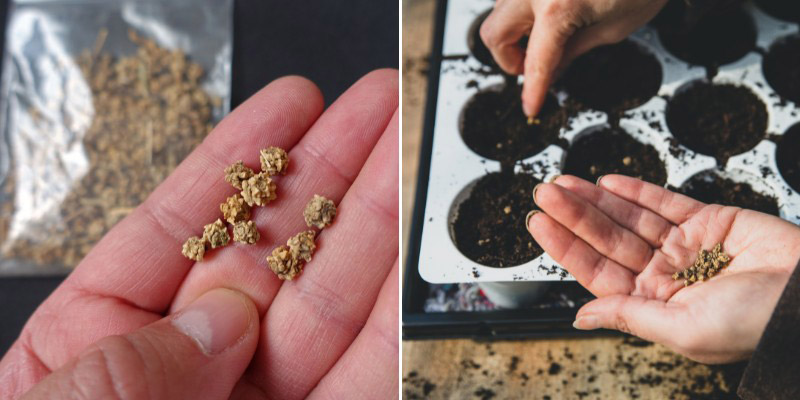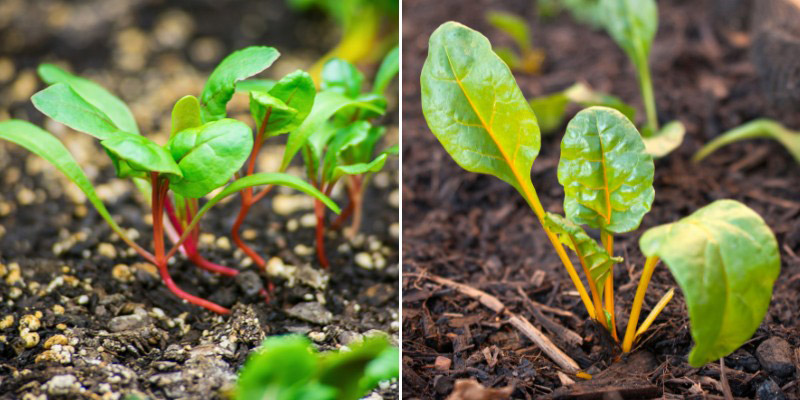Swiss chard, also called silverbeet or chard, is a leaf vegetable appreciated for its delicate flavour, which resembles spinach, and its high nutritional value, since it is rich in vitamins, minerals and antioxidants. It is also very decorative, as it is available in different colours: yellow, pink, red or white. If you want to grow chard in your garden, follow this step-by-step guide to succeed with their sowing.
For full information about their cultivation, see our complete fact sheet: "Chard, silverbeet: planting, growing, harvest"
When to sow chard?
Chard can be sown either in pots, under cover, from March, or directly in open ground in early spring, in April–May, even up to July. It can be harvested about two months after sowing. In cold regions, favour sowing under cover, while in regions with a mild climate you can sow directly in open ground in spring.
How to sow chard under cover?
Sowing under cover allows you to start growing chard earlier in the season, generally 4 to 6 weeks before last frost date in your area. This gives young plants time to get a head start and be ready to be transplanted to open ground as soon as climatic conditions allow.
Required equipment
- Chard seeds
- Pots, alveolate trays or seed trays
- Light, well-draining potting compost, ideally a seed and transplant compost.
- A mini greenhouse or a transparent cover will help maintain humidity and warmth around seeds.
- Labels, to remember variety and sowing date.
How to proceed?

- Fill pots or alveolate trays with seed compost. Firm compost lightly and water evenly before sowing seeds.
- Sow 2 to 3 chard seeds per pot, pressing them about 1 cm deep.
- Cover seeds with a fine layer of compost (around 1 cm deep) and press lightly.
- Water gently after sowing, taking care not to displace seeds.
- Place pots in a mini greenhouse to maintain humidity and warmth. A transparent cover can also be used.
- Place mini greenhouse in a warm, bright spot with temperature between 18 and 24°C. Germination usually takes 7 to 14 days.
- When seedlings have 2 to 3 leaves, thin them out leaving only one plant per cell or bucket. Remove weaker plants carefully. You can transplant them individually into pots or buckets to give remaining plants enough room to develop.
- Water chard regularly, ensuring compost stays moist but not waterlogged.
- About 10 to 14 days before planned transplanting to open ground, begin to harden off seedlings by gradually exposing them to outdoor conditions. Place them outdoors for a few hours a day, increasing exposure time and protecting from frost and wind.
- When chard plants reach about 10 to 15 cm in height and climatic conditions are favourable, transplant to open ground. Take care when transplanting as chard has a taproot that can be damaged.

How to sow chard in open ground?
Required equipment
- A spade or fork to loosen soil
- A rake
- Chard seeds
- A watering can with rose
- Well-rotted compost
How to proceed?
Choose a sunny or lightly shaded spot in your garden to sow chard. It tolerates partial shade but performs better with at least 4 to 6 hours of sun per day. Chard prefers well-drained soil rich in organic matter.
- Start by loosening soil with a spade or broadfork. Remove weeds and large stones. Add some compost if needed.
- Level soil with a rake.
- Mark out shallow furrows (about 1 cm deep), spaced 30 to 40 cm apart.
- Sow seeds of chard in furrows, spacing them about 5 cm apart. You can also sow in 3-seed clusters every 40 cm.
- Cover seeds lightly with soil and press gently with back of rake.
- Water gently after sowing, taking care not to displace seeds.
- Keep soil moist until germination, which usually takes 7 to 14 days.
- When seedlings have 3 to 4 leaves, thin to one plant every 30 to 40 cm. You can transplant thinned plants to other parts of the garden or give them to friends.
Water chard regularly, especially during dry periods, and keep soil moist but not waterlogged. Mulching around plants will help retain moisture and control weeds. Feed chard with a nitrogen-rich fertiliser every 4 to 6 weeks to encourage healthy growth.
Chard is generally ready to harvest about two months after sowing. Harvest as needed, taking larger outer leaves first. Cut leaves at base, leaving at least two leaves per plant to allow new growth.

































Comments